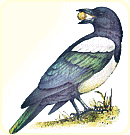Comic strips bring joy to millions around the world daily. The comic strip is one form of cartoon art.
 Cartoon philosophy relates to the philosophy of art
Cartoon philosophy relates to the philosophy of art
The estimation of cartoon art may be primarily evaluative.
Cartoon art philosophy needs to be distinguished from cartoon art criticism, which may be
more or less peripheral. ◊
Cartoon art is not limited to visual cartoon art; music and drama and poetry may
intermingle. One may also see paintings of cartoon figures and scenes, sculptures, and a
variety of objects for sale.
 For future philosophers of cartooning
For future philosophers of cartooning
The philosopher of cartoon art asks as if in a pensive mood:
- What is meant by saying that a work of cartoon art is expressive and how does
one determine if it is?
- What distinguishes fine cartoon art from useful cartoon art, if clear enough
hallmarks are found yet?
- What it is about comic strips that evokes mirth in us?
- What does the philosopher of cartoon art direct his attention on?
- What is cartoon art and what distinguishes it from all other things?
Answers may differ. But in every case the aim of cartoon art criticism is to attain
an increased understanding or enjoyment of the work (or classes of works) of cartoon art.
Speaking of enjoyment, however, if the term "cartoon art" is to be used without confusion,
bad cartoon art as well as good cartoon art may exist.
Cartoon philosophers may classify cartoon art findings in several ways: ◊
- Narrow, aesthetical thinking may be brought to bear on it.
- Popularity with its where's, why's and how's, is one angle.
- Judging the values or possible values of single strips as well as larger
portions.
- Differentiating between various sorts (including classes) of cartoon works -
such as useful and not useful, valuable and not valuable.
- Valuing certain styles or genres.
- Relating strips to their time periods, epochs, with elucidations based on the
cartoon art periods till now.
 Aesthetic cartoon work revolves around the concepts of beauty and "I like"
Aesthetic cartoon work revolves around the concepts of beauty and "I like"
USEFUL cartoon art may have both an aesthetic and a utilitarian dimension: We may find
solid cartoon works in educational material, and enjoy some of them as objects
of beauty and otherwise too.

- Cartoon philosophy is coming into being in our days.
- Future cartoon philosophers may draw inspiration from art philosophy and other quarters alike, and blend or streamline the most convenient facets to suit this medium.
- Aesthetic concepts are not wholly removed from aestethic objects that surround us.
 Cartoon philosophy is to be streamlined to suit this kind of expressiveness. If you sit down at your carefully designed, comfortable table and take your preferred
tools in hand, you should have some ideas or facts to toy with if you have no sensible
inspiration - which may come later as a result of setting your deep mind at work through
interest or work for some time. Good routines and fine, inspiring how-to-do-it books and
examples can further much.
Cartoon philosophy is to be streamlined to suit this kind of expressiveness. If you sit down at your carefully designed, comfortable table and take your preferred
tools in hand, you should have some ideas or facts to toy with if you have no sensible
inspiration - which may come later as a result of setting your deep mind at work through
interest or work for some time. Good routines and fine, inspiring how-to-do-it books and
examples can further much.
